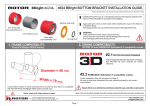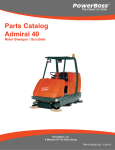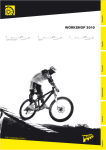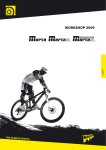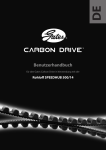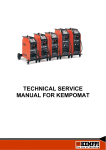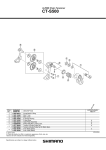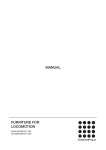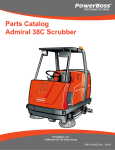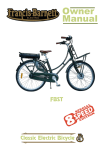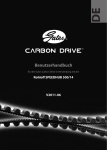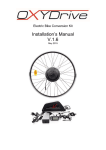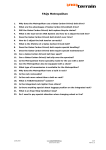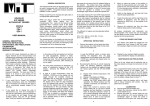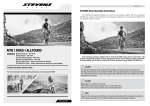Download Gates Belt Ruler - G-Boxx
Transcript
Universal transmissions GmbH Külftalstr. 18 31093 Lübbrechtsen Germany phone: (49)-5185-60266-50 [email protected] www.carbondrivesystems.com GATES belt ruler and tension tester User manual Thank you for choosing the Carbon Drive equipment to install the drive system correctly. On the following pages a testing method will introduced to check easily the correct belt line and the belt tension. Please read this manual carefully before you start with the first measurements. If you got any additional questions to the measurement procedure feel free to contact us. [email protected] . fig. 1: Multi purpose tool to check the belt line and the belt tension 1 Content Basics ......................................................................................................................... 3 Part list........................................................................................................................ 4 Checking the beltline .................................................................................................. 5 Adjustment of the belt line .......................................................................................... 8 Checking the belt tension ......................................................................................... 10 Measurement............................................................................................................ 10 2 Basics Beltline: A correct aligned belt line is absolutely required to receive a secure and carefree system. The correct beltline is also important to receive the high efficiency of the system. The beltline is specified by the used hub type. The Position of the front sprocket needs to be aligned depending on the hub type. The fine adjustments are also necessary in order to compensate the frame or component tolerances. The front sprocket and the rear pulley should aligned in a way that they are located on one plane. An incorrect aligned beltline is shown on fig. 2. The displacement (a) of the sprockets will lead the belt to run of the sprockets. This procedure could damage the belt and might cause a dangerous crash. Displacements of the sprockets can also increase the friction of the system and therefore decrease the efficiency. fig 2: Incorrect aligned beltline. Displacement shown through a Belt tension: Proper belt tension is absolutely required to receive a secure and durable drive system. A belt tension against the specification can lead to an increased wearing. Lack of belt tension can lead to so-called ”ratcheting”, which means that the belt will jump over the teeth of the rear pulley. Ratcheting could damage the carbon tensile cords. 3 Part list Nr. Quantity. Description 01 1 pcs. base 02 1 pcs. testing weigth 1Kg 03 1 pcs. guide plate 04 1 pcs. adjustment bar 05 2 pcs. washer 06 1 pcs. testing needle 07 1 pcs. tension indicator 08 1 pcs. measurement shaft 09 2 pcs. cylinder head bolt M8 x 16mm 10 1 pcs. cylinder head bolt M5 x 12mm 10 4 pcs. counter sunk bolt M6 x 14mm 11 2 pcs. dowel 6 x 14mm 12 1 pcs. set screw M5 Illustration The measurement device is already pre-assembled. To make the individual adjustments please use the following tools. Tools are not included in delivery 1x 6mm Allen key 1x 4mm Allen key 4 Checking the beltline The measurement device can be used on a fully equipped bicycle. It is useful to fix the bike in an assembly stand in order to get an ergonomic position to check the beltline. Please consider that the chain stays are aligned parallel to the ground (fig. 3). Please pay attention to the secure stand of the assembly stand! fig. 3: Bicycle fixed in an assembly stand The testing weight is not necessary to check the beltline. Please remove the weight before measuring. As a first step the fine adjustment of the measurement device needs to be done. Via the adjustment bar the device can be adjusted in order to match the device to different chain stay length. Please loose the two M8 cylinder head bolts which are fixing the adjustment bar (fig. 4, Pos. 1). Afterwards the length can be adjusted in a way that the testing needle reaches the inside flange of the rear pulley. The testing needle is an indicator if the belt line is aligned correctly. The needle has to be proper adjusted to the different beltlines as well. Please loose the M5 cylinder head bolt to adjust the testing needle (fig.4, Pos. 2.). 5 Pos. 2 Pos. 1 fig. 4: Fastening bolts to adjust the belt ruler The beltline is specified by the used hub. Three possible beltlines are listed in the chart below (Chart 1). Chart 1: Measurements at the testing needle Measurement at the Hub type testing needle D Rohloff Speedhub Shimano Nexus/ Alfine 9Spline freewheel body 10,0mm 12,0mm 13,0mm Please adjust the testing needle to the used hub type. The value D should be measured at the surfaces which are shown in fig. 5. fig. 5: Partial view of the belt ruler. Measuring face to adjust the belt line 6 The belt ruler is now adjusted properly. Please follow the next step to check the belt line. To check the belt line the belt ruler needs to be positioned at the mounted front sprocket with its parallel face (fig. 6). If the belt line is already adjusted the face of the testing needle should touch the inside of the flange of the rear sprocket. fig. 6: test setup to check the belt line In the case that the belt line is not aligned properly please use the following procedure to receive the correct adjustment. 7 Adjustment of the belt line The beltline can be adjusted by using the washer set. The washer set is included in the front sprocket delivery. It consists of washers with two different thicknesses to be able to fine adjust the belt line. The needed washers are mounted between the surface oft he crank arm and the front sprocket (fig. 7). Some bottom bracket units (e.g. Shimano Hollowtech or Truvativ GXP) allow the fine adjustment via washers between the bottom bracket shell and the BB housing (fig. 8). Please pay attention to the instructions for installation of the bottom bracket which is supplied by the BB manufacturer. fig. 7: Assembly of the front sprocket If your bike is equipped with an eccentric bottom bracket you can set the belt line by adjusting the bottom bracket unit axial in the bottom bracket housing. Please pay attention to the instructions for installation of the eccentric bottom bracket which is supplied by the bike manufacturer. 8 Washer set: 2 pcs. 10x16x1mm 1 pcs. 10x16x0,5mm 2 pcs. 41x35x1mm 1 pcs. 41x35x0,5mm fig 8: belt line alignment via bottom bracket spacer 9 Checking the belt tension The checking of the belt tension can perfomed at an assembled bike as well. The procedure can be done in an assembly stand or directly at the bicycle. To prepare the measurement device the provided testing weight needs to screw on the measurement shaft (fig. 9). fig 9: Preparation for the tension measurement Measurement The belt ruler has to be positioned on top of the drive section (tight span) to check the belt tension. In order to receive reliable test results the belt ruler should applied in a way that the tension indicator pushes in the middle of the drive section. A force from about 10N is introduced perpendicular on top of the belt. The generated deflection is a measurement of the pre-tension of the Carbon Drive system. The array of the tension will be shown through the indicator opening. The following tension arrays will be shown: - The Carbon Drive System is correctly tensioned (fig. 10). There are no tension adjustments necessary. Low wearing and the highest efficiency are accomplished in this array. - The belt tension is too high. Please decrease the belt tension via the adjustable horizontal dropouts or the eccentric bottom bracket. If the belt tension won´t be increased fast belt wearing can occur. The stress on the bearings of the rear hub and the bottom bracket will also raise to a level where high wearing is possible. - The belt tension is to low (fig. 11). Please decrease the tension of the belt via the horizontal dropouts or the eccentric bottom bracket. Lack of belt tension can lead to so-called ”ratcheting”, which means that the belt will jump over the teeth of the rear pulley. Ratcheting can damage the carbon tensile cords. Important! Initial setting: The carbon fibers on the inside of the belt are in an unstressed state before the first assembly. If the belt is mounted for the first time and tensioned for the first time, the carbon fibers move to their working position (tensioned). This process causes a minimal change in length of the belt. This is called initial settling. To compensate this settling behavior the belt will be tensioned about 15% above the optimum belt tension. The belt tension during first assembly can also be easily verified with the belt ruler. Prior to delivery of the bike to the customer the tension indicator should show 50% yellow and 50% green in the indicator opening Tip: The belt ruler can be positioned on top of the belt while tensioning the belt via the horizontal dropouts or the eccentric BB Unit. This is an easy way to notice when the belt is tensioned correctly. fig10: Correct belt tension. Green array is shown in the indicator indi opening fig 11: Belt tension low. Red array is shown in the indicator opening













